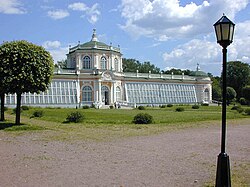A herb garden is a garden specifically designed and used for the cultivation of cooking , magical, and/or medicinal herbs.
Herb gardens developed from the general gardens of the ancient classical worlds, used for growing vegetables, flowers, fruits and medicines. During the medieval period, monks and nuns acquired specialist medical knowledge and grew the necessary herbs in specialist gardens. Typical plants were rosemary, parsley, sage, marjoram, thyme, mint, rue, angelica, bay, oregano, dill and basil. With the advance of medical and botanical sciences in Renaissance Europe, monastic herb gardens developed into botanical gardens. The section in which herbs was grown became known as a Garden of Simples.
Herb gardens experienced a revival with the work of the British garden historian and horticultural, writer Eleanour Sinclair Rohde (1882–1950). Modern herb gardens may be purely functional or may be ornamental, sometimes as part of a design and containing boxes and raised beds. The development of alternative medicine is also encouraging people to grow and use fresh herbs (e.g., for the treatment of acne).
OrangeryAn Orangery was a building frequently found in the grounds of fashionable residences from the 17th to the 19th century. Similar to a greenhouse or conservatory. The name is derived from the original use of the building as a place where citrus trees were often grown in tubs and wintered under cover. The orangery originated from the Renaissance gardens of Italy, when glass-making technology enabled sufficient expanses of clear glass to be produced.
 The Orangerie at the Palace of the Louvre, 1617, inspired imitations that were not eclipsed until the development of the modern greenhouse in the 1840s, which was quickly overshadowed by the architecture in glass of Joseph Paxton. Notable for his design of the Crystal Palace, his "great conservatory" at Chatsworth House was an orangery and glass house of monumental proportions.
The Orangerie at the Palace of the Louvre, 1617, inspired imitations that were not eclipsed until the development of the modern greenhouse in the 1840s, which was quickly overshadowed by the architecture in glass of Joseph Paxton. Notable for his design of the Crystal Palace, his "great conservatory" at Chatsworth House was an orangery and glass house of monumental proportions.
The orangery, however, was not just a greenhouse but a symbol of prestige and wealth and a feature of the garden, in the same way as a summerhouse, folly or "Grecian temple".
Orangerieschloss built by Frederick William IV of Prussia in Potsdam in the mid-19th century, in imitation of the Italian Renaissance style
Owners would The conduct their guests there on tours of the garden to admire not only the fruits within but the architecture without. Often the orangery would contain fountains, grottos, and an area in which to entertain in inclement weather.







No comments:
Post a Comment